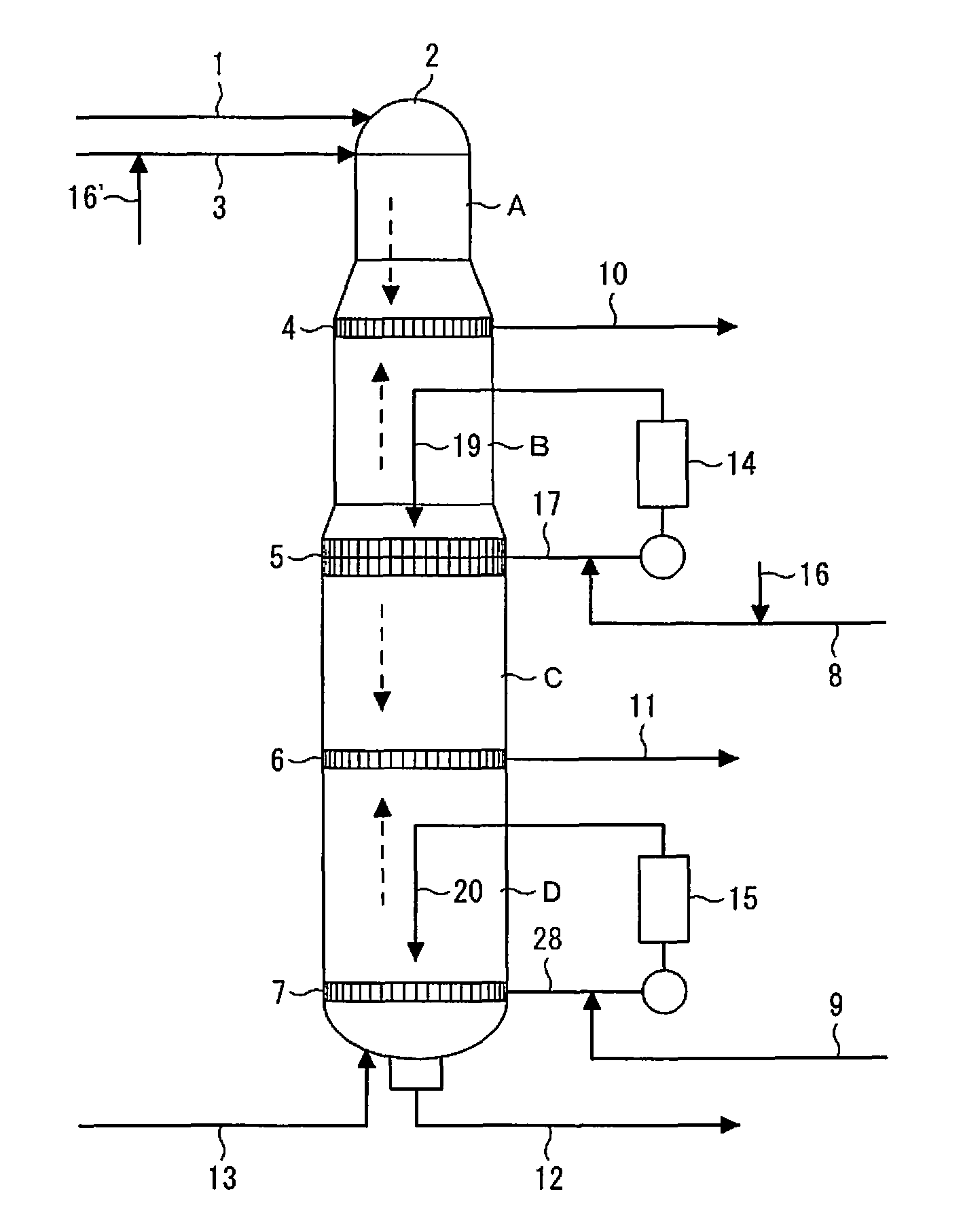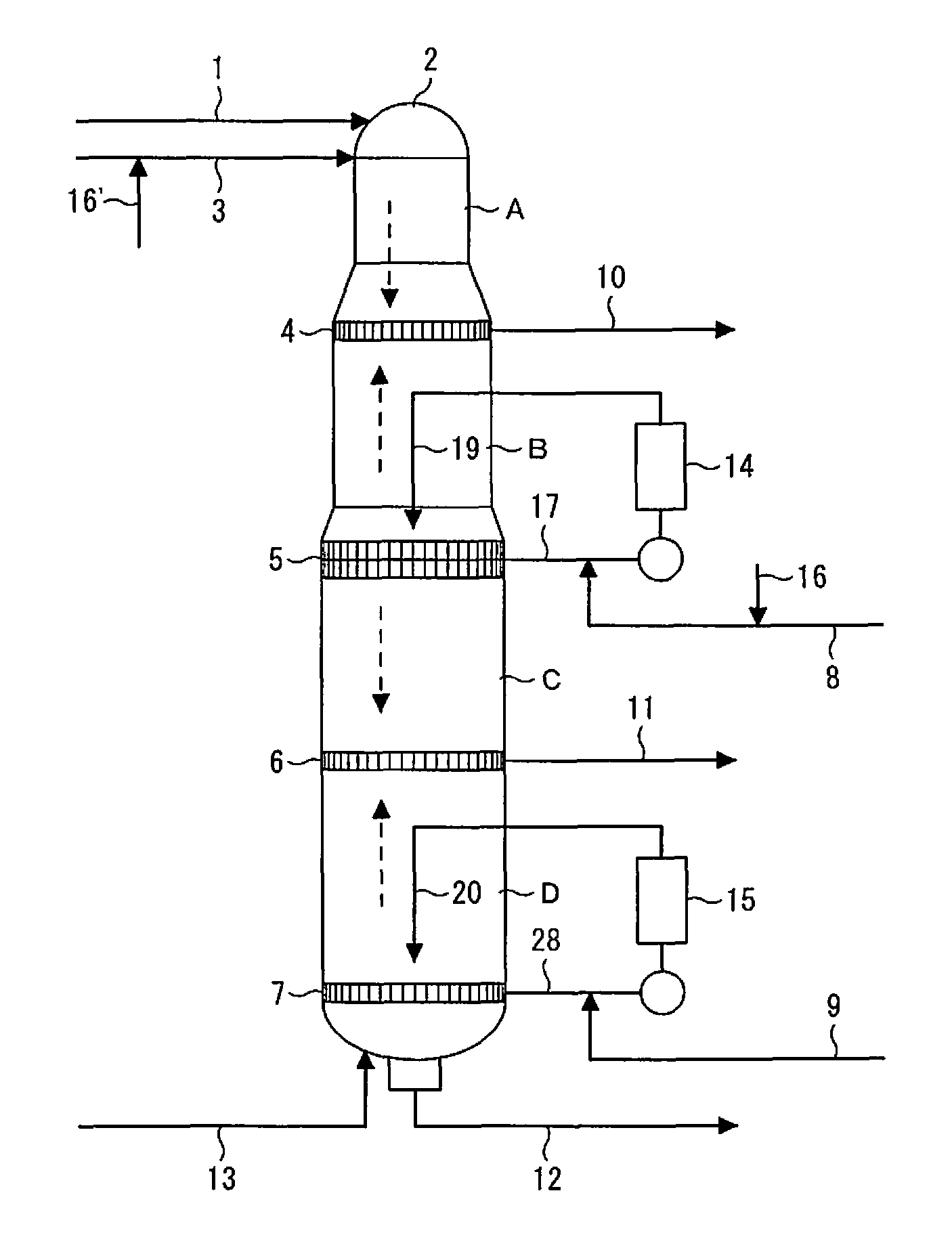Cooking process of lignocellulose material
a technology of lignocellulose and cooking process, which is applied in the direction of multi-stage pulping process, continuous pulping process, and pulping with inorganic bases, etc., can solve the problem that the recovery boiler has enough capacity to recover, and achieve the effect of improving the relation between the kappa number and the pulp yield, improving the pulp yield and improving the yield
- Summary
- Abstract
- Description
- Claims
- Application Information
AI Technical Summary
Benefits of technology
Problems solved by technology
Method used
Image
Examples
example 1
[0074]Using chips obtained by mixing 40 mass % of radiata pine, 30 mass % of Douglas fir and 30 mass % of larch, each on a bone-dry weight basis, cooking was carried out by use of a continuous digester shown in FIG. 1. Three total effective alkali addition rates (relative to bone-dry chips; converted to Na2O) of 14.5, 16.5 and 18.5 mass % were used. A first cooking liquor having the following formulation was added to the top of the digester. A liquor ratio to the bone-dry chips was at about 3.5 L / kg as combined along with the moisture accompanied with the chips.
[0075]First cooking liquor: an alkaline cooking liquor (a polysulfide sulfur concentration of 4 g / L (converted to sulfur, a concentration in a whole alkaline cooking liquor herein and whenever it appears hereinafter), a sodium hydroxide concentration of 70 g / L (converted to Na2O), and a sodium sulfide concentration of 20 g / L (converted to Na2O)), which is obtained by mixing an amount of an anode liquor obtained by electrochem...
example 2
[0080]This example was carried out in the same manner as in Example 1 with respect to the chips used for the cooking, the total effective alkali addition rates, the liquor ratios, the electrolyzer used for electrolysis, the cooking black liquor extraction from the upper and lower extraction strainers, the temperatures, the times and the H-factor of the digester, and the addition of the quinone compound. A first cooking liquor having the following formulation was added to the top of the digester.
[0081]First cooking liquor: an alkaline cooking liquor (a polysulfide sulfur concentration of 8 g / L (converted to sulfur), a sodium hydroxide concentration of 70 g / L (converted to Na2O), and a sodium sulfide concentration of 13 g / L (converted to Na2O)), which is obtained by mixing an amount of an anode liquor obtained by electrochemically oxidizing, with the above-indicated electrolyzer, 72 mass % of an alkaline liquor containing sodium hydroxide and sodium sulfide as main components and 28 m...
example 3
[0084]This example was carried out in the same manner as in Example 1 with respect to the chips used for the cooking, the total effective alkali addition rates, the liquor ratios, the electrolyzer used for electrolysis, the cooking black liquor extraction from the upper and lower extraction strainers, the temperatures, the times and the H-factor of the digester, and the addition of the quinone compound. A first cooking liquor having the following formulation was added to the top of the digester.
[0085]First cooking liquor: an alkaline cooking liquor (a polysulfide sulfur concentration of 10 g / L (converted to sulfur), a sodium hydroxide concentration of 70 g / L (converted to Na2O), and a sodium sulfide concentration of 10 g / L (converted to Na2O)), which is obtained by mixing a whole amount of an anode liquor obtained by electrochemically oxidizing, with the above-indicated electrolyzer, 90 mass % of an alkaline liquor containing sodium hydroxide and sodium sulfide as main components an...
PUM
| Property | Measurement | Unit |
|---|---|---|
| concentration | aaaaa | aaaaa |
| concentration | aaaaa | aaaaa |
| concentration | aaaaa | aaaaa |
Abstract
Description
Claims
Application Information
 Login to View More
Login to View More - R&D
- Intellectual Property
- Life Sciences
- Materials
- Tech Scout
- Unparalleled Data Quality
- Higher Quality Content
- 60% Fewer Hallucinations
Browse by: Latest US Patents, China's latest patents, Technical Efficacy Thesaurus, Application Domain, Technology Topic, Popular Technical Reports.
© 2025 PatSnap. All rights reserved.Legal|Privacy policy|Modern Slavery Act Transparency Statement|Sitemap|About US| Contact US: help@patsnap.com



